Index of articles related to Indigenous Canadians
The following is an alphabetical list of topics related to Indigenous peoples in Canada, comprising the First Nations, Inuit and Métis peoples.
| Indigenous peoples in Canada |
|---|
.JPG.webp) |
|
A
- Aatsista-Mahkan (Running rabbit)
- Abenaki mythology
- Aboriginal Curatorial Collective
- Aboriginal Day of Action
- Aboriginal land claim
- Aboriginal Multimedia Society of Alberta
- Aboriginal Nurses Association of Canada
- Aboriginal Peoples Television Network
- Aboriginal People's Party
- Aboriginal Peoples Party of Canada
- Aboriginal police in Canada
- Aboriginal title
- Aboriginal Voices
- Aboriginal whaling
- Agreement Respecting a New Relationship Between the Cree Nation and the Government of Quebec
- Aleutian tradition
- Allied Tribes of British Columbia
- Amauti – Inuit parka
- Angakkuq
- Anglo-Métis
- Anishinaabe traditional beliefs
- Anishinaabe tribal political organizations
- Archaic period in the Americas
- Arctic Council
- Arctic small tool tradition
- Assembly of First Nations leadership conventions
- Athabaskan languages
- Attorney General of Canada v. Lavell
- Azeban
B
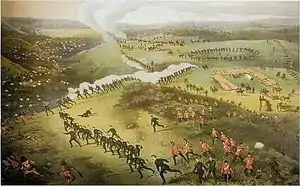 The North-West Rebellion (or North-West Resistance or the Saskatchewan Rebellion) of 1885 was a brief and unsuccessful uprising by the Métis people of the District of Saskatchewan under Louis Riel against the Dominion of Canada, which they believed had failed to address their concerns for the survival of their people. Despite some early victories at Duck Lake, Fish Creek and Cut Knife, the rebellion resulted in the destruction of numerous Métis and allied First Nations forces. |
- Battle of Fallen Timbers
- Battle of Fish Creek
- Battle of Fort Pitt
- Battle of Frenchman's Butte
- Battle of Hudson's Bay
- Battle of Loon Lake
- Battle of Long Sault
- Battle of the Belly River
- Battle of Seven Oaks (1816)
- Bannock (food)
- Beaver Wars
- Bell of Batoche
- Beothuk
- Bibliography of Canada
- Big Bear (mistahi-maskwa)
- Birnirk culture
- Blackfoot language
- Blackfoot music
- Blackfoot religion
- Blond Eskimos
- Bloody Falls Massacre
- Bridge River Rapids
- 2002 British Columbia aboriginal treaty referendum
- British Columbia Treaty Process
- British North America Acts
- Brocket 99
- Burnt Church Crisis
- Bungee language
C
In the United States and Canada, ethnographers commonly classify indigenous peoples into ten geographical regions with shared cultural traits (called cultural areas). |
- Canadian Aboriginal law
- Canadian Aboriginal syllabics
- Canadian House of Commons Standing Committee on Aboriginal Affairs and Northern Development
- Canadian Indian residential school system
- Canadian Polar Commission
- Canadian Senate Standing Committee on Aboriginal Peoples
- Caribou Inuit
- Centre for Indigenous Theatre
- Center for World Indigenous Studies
- Chief Pontiac (Obwandiyag)
- Chimney Rock (Canada)
- Chippewas of Sarnia Band v. Canada (Attorney General)
- Christ Church Royal Chapel
- CHRS-FM
- Classification of indigenous peoples of the Americas
- Indigenous languages of the Americas
- Arctic cultural area – (Eskimo–Aleut languages)
- Subarctic culture area – (Na-Dene languages – Algic languages)
- Eastern Woodlands (Northeast) cultural area – (Algic languages and Iroquoian languages)
- Plains cultural area – (Siouan–Catawban languages)
- Northwest Plateau cultural area – (Salishan languages)
- Northwest Coast cultural area – (Penutian languages, Tsimshianic languages and Wakashan languages)
- Indigenous languages of the Americas
- Coast Salish peoples
- Coast Salish art
- Coast Salish languages
- Coast Tsimshian
- Congress of Aboriginal Peoples
- Constitution Act, 1982
- Council of Three Fires
D
E
F
.gif) 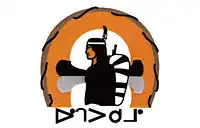   First Nations is a term of ethnicity that refers to the Aboriginal peoples in Canada, who are neither Inuit nor Métis. |
- First Nations (A main article)
- First Nations Bank of Canada
- First Nations Composer Initiative
- First Nations Government (Canada)
- First Nations Health Authority
- First Nations Periodicals
- First Nations Police (Ontario)
- First Nations Summit
- First Nations Technical Institute
- First Nations Transportation
- First Nations University Students' Association
- First Nations University of Canada
- First Nations in Alberta
- First Nations in Atlantic Canada
- First Nations in British Columbia
- First Nations in Manitoba
- First Nations in New Brunswick
- First Nations in Ontario
- First Nations in Quebec
- First Nations in Saskatchewan
- First Nations language
- First Nations music
- First Nations social issues
- First Nations studies
- First Peoples' Heritage, Language and Culture Council
- First Battle of Bloody Creek
- Five Medals
- Folsom point
- Folsom tradition
- Franco-Indian alliance
- Fraser Canyon War
- French and Indian War
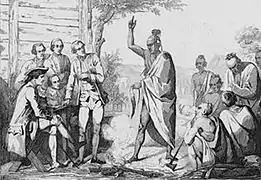 The French and Indian War, also known as the War of the Conquest (French: Guerre de la Conquête) or referred as part of the larger conflict known as the Seven Years' War, was a war fought in North America between 1754 and 1763. The name French and Indian War refers to the two main enemies of the British: the royal French forces and the various Indigenous peoples forces allied with them. |
- Battle of Fort Beauséjour (June 16, 1755)
- Siege of Louisbourg (June 8 – July 26, 1758)
- Battle of Fort Frontenac (August 25, 1758)
- Battle of the Thousand Islands, August 16–25, 1760
- Battle of Beauport (July 31, 1759)
- Battle of the Plains of Abraham (September 13, 1759)
- Battle of Sainte-Foy (April 28, 1760)
- Battle of Restigouche, July 3–8, (1760)
- Battle of Signal Hill September 15, 1762
- Food of the Tlingit
- Frog Lake Massacre
- Fort Defiance (British Columbia)
- Fort Fraser, British Columbia
- Fort Garry
- Fort Saint Vrain
- Fort Simpson (Columbia Department)
- Fort St. James, British Columbia
- Fort Stikine
- Fort Vancouver
- Fort Vancouver National Historic Site
- Fort Vasquez
- Fort Ware, British Columbia
- The Fur Trade at Lachine National Historic Site
- Fur brigade
- Fred Quilt inquiry
- Fur seal
G
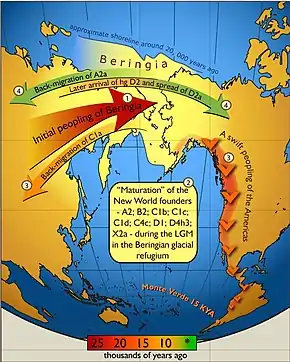 The haplogroup most commonly associated with Indigenous Amerindian genetics is (Y-DNA) Q1a3a /Q-M3. In human genetics, the haplogroups generally studied are Human Y-chromosome DNA haplogroups and Human mitochondrial DNA haplogroups. The Q-M3 mutation on the Q lineage is roughly 10,000 to 15,000 years ago, as the migration throwout the Americas was underway by the early Paleo-Indians. |
H
- Haplogroup C-M217 (Y-DNA)
- Haplogroup Q-M242 (Y-DNA)
- Haplogroup Q-MEH2 (Y-DNA)
- Haplogroup Q-NWT01 (Y-DNA)
- Haplogroup Q-P89.1 (Y-DNA)
- Haplogroup Q-M3 (Y-DNA)
- Haplogroup R1 (Y-DNA)
- Haldimand Proclamation
- Hamatla Treaty Society
- Haida Argillite Carvings
- Haida language
- Haida manga
- Haida mythology
- Haisla language
- Head-Smashed-In Buffalo Jump
- Heiltsuk language
- High Arctic relocation
- History of Canada
- History of Alberta#Pre-Confederation
- History of the west coast of North America
- History of Squamish and Tsleil-Waututh Longshoremen, 1863-1963
- Hivernants
- Hopewell tradition
- Hudson's Bay Company
- Hul'qumi'num Treaty Group
I
- Igloo
- Ihalmiut
- Indian Act
- Indian Agent (Canada)
- Indian Department
- Indian Health Transfer Policy (Canada)
_a_Kwakwaka'wakw_big_house.jpg.webp) The Indigenous peoples of the Pacific Northwest Coast are the pre-Columbian inhabitants of the Pacific Northwest Coast, their descendants, and many ethnic groups who identify with those historical peoples. They are now situated within the Canadian province of British Columbia and the U.S. states of Alaska, Washington and Oregon. |
- Indians of Canada Pavilion
- Indian Posse
- Indian Register
- Indian Residential Schools Truth and Reconciliation Commission
- Indian Reserve (1763)
- Indian settlement
- Indian and Northern Affairs Canada
- Indigenous archaeology
- Indigenous Canadian personalities
- Indigenous Dialogues
- Indigenous (ecology)
- Indigenous food security in Canada
- Indigenous intellectual property
- Indigenous knowledge
- Indigenous land claims in Canada
- Indigenous language
- Indigenous languages of the Americas
- Indigenous medicine
- Indigenous music of Canada
- Indigenous peoples by geographic regions
- Indigenous peoples in Northern Canada
- Indigenous peoples in Quebec
- Indigenous peoples of the Americas
- Indigenous peoples of the Pacific Northwest Coast
- Indigenous rights
- Indspire
- Indspire Awards
- International Work Group for Indigenous Affairs
- Institute of Indigenous Government
- Inu-Yupiaq
 Inuit is a general term for a group of culturally similar indigenous peoples inhabiting the Arctic regions of Canada, Greenland, Russia and the United States. |
- Inuit-Aleut
- Inuit art
- Inuit astronomy
- Inuit Boots
- Inuit Broadcasting Corporation
- Inuit Circumpolar Council
- Inuit Circumpolar Conference
- Inuit culture
- Inuit diet
- Inuit Dog
- Inuit grammar
- Inuit language
- Inuit mask
- Inuit music
- Inuit mythology
- Inuit numerals
- Inuit phonology
- Inuit Qaujimajatuqangit
- Inuit snow goggles
- Inuit syllabary
- Inuit Tapiriit Kanatami
- Inuit throat singing
- Inuit weapons
J
K
- Kabloona
- Kahnawake Gaming Commission
- Kahnawake Iroquois and the Rebellions of 1837–38
- Kainai
- Kamloops Wawa
- Kayak
- Kwak'wala
- Kwakwaka'wakw mythology
- Kwakwaka'wakw art
- Kwakwaka'wakw music
- Kegedonce Press
- Koyukons
- King George's War
- King William's War
- Kwäday Dän Ts’ìnchi
- Kwakwaka'wakw
- Kwakwaka'wakw art
- Kruger and al. v. The Queen
- Kudlik
L
- Lacrosse
- Lachine massacre
- Land ownership in Canada
- Laurel Complex
- List of Algonquin Chiefs
- List of archaeological periods (North America)
- Lithic stage (pre 8000 BC)
- Archaic stage (c. 8000 – 1000 BC)
- Formative stage (c. 1000 BC – AD 500)
- Classic stage (c. AD 500–1200)
- Post-Classic stage (c. 1200–1900)
 Founder of the province of Manitoba and a leader of the Métis during the Red River Rebellion of 1869 and North-West Rebellion of 1885. |
- List of bibliographical materials on the potlatch
- List of Canadians
- List of Canadians#Aboriginal leaders
- Big Bear (1825–1888) – Cree leader
- Brant, Joseph (1742–1807) – Mohawk leader
- Brant, Mary (1736–1796) – leader of Six Nations women's federation
- Riel, Louis (1844–1885) – leader of two Métis uprisings
- Piapot (c. 1816–1908) – Cree Chief
- Tecumseh (1768–1813) – Shawnee leader
- Nicola 1780/1785 – c. 1865 – Grand chief of the Okanagan people, and jointly chief of the Nlaka'pamux
- Nicola Athapaskan alliance in the Nicola Valley and of the Kamloops group of the Secwepemc
- Cumshewa – 18th-century Haida chief at the inlet now bearing his name
- Maquinna – 18th-century Nuu-chah-nulth chief (Yuquot/Mowachaht).
- Wickanninish 19th-century Nuu-chah-nulth chief (Opitsaht/Tla-o-qui-aht)
- August Jack Khatsahlano – Squamish
- Joe Capilano – Squamish
- Harriet Nahanee – Squamish and Nuu-chah-nulth (Pacheedaht)
- Andy Paull – Squamish
- Frank Calder – Nisga'a
- Elijah Harper – Cree and/or Ojibwe
- Guujaaw – modern-day Haida leader
- Shawn Atleo
- William Beynon
- Rose Charlie
- Arthur Wellington Clah
- Heber Clifton
- Harley Desjarlais
- Alfred Dudoward
- Chief Shakes
- Dan George – Tsleil-Waututh First Nation (Burrard)
- Joseph Gosnell – Nisga'a
- Simon Gunanoot – Gitxsan
- Chief Hunter Jack ( –d.1905) – St'at'imc
- Mary John, Sr.
- Klattasine – Tsilhqot'in war chief, surrendered on terms of amnesty in times of war, hanged for murder
- Koyah – 18th-century chief of the Haida
 Shanawdithit, also referred to as "Shawnadithit" and "Nancy April", was the last recorded surviving member of the Beothuk people of Newfoundland, Canada. She died of tuberculosis on 6 June 1829 in St. John's at the age of 28. |
- George Manuel
- Shanawdithit
- Stewart Phillip
- Steven Point – modern Sto:lo leader, Lieutenant-Governor of British Columbia 2007–12
- James Sewid – Kwakwaka'wakw
- Alec Thomas
- Walter Wright
- List of Chinook Jargon placenames
- List of community radio stations in Canada
- List of conflicts in Canada
- List of English words from indigenous languages of the Americas
- List of First Nations governments
- List of First Nations people
- List of First Nations peoples
- List of Indian reserves in Canada
- List of Indian reserves in Canada by population
- List of Indian residential schools in Canada
- List of indigenous peoples
- List of Canadian Inuit
- List of Métis people
- List of place names in Canada of Aboriginal origin
- List of placenames of indigenous origin in the Americas
- List of pre-Columbian cultures
- List of tribal councils in British Columbia
- List of writers from peoples indigenous to the Americas
- Looting of Battleford
![]() Louis Riel (A feature class article)
Louis Riel (A feature class article)
M
- Makah language
- Malsumis
- Manitoba Band Operated Schools
- Manitou
- Maritime Archaic
- McKenna-McBride Royal Commission
- McNally Robinson Aboriginal Book of the Year Award
- Michif language
- Minister of Aboriginal and Northern Affairs (Manitoba)
- Minister of Indian Affairs and Northern Development (Canada)
- Missing and murdered Indigenous women
- Mitchell v. M.N.R.
- Models of migration to the New World
- Mokotakan
- Meech Lake Accord
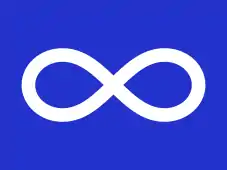  The Métis are a people descended from marriages between Europeans and First Nations and Inuit. Their history dates to the mid-17th century. |
- Anglo-Métis
- Metis Child and Family Services Society
- Métis Flag
- Métis French
- Metis Comprehensive Land Claim Agreement
- Métis National Council
- Métis Nation of Alberta
- Métis Nation British Columbia
- Manitoba Métis Federation
- Métis Nation - Saskatchewan
- Métis Nation of Ontario
- Métis Population Betterment Act
- Métis-sur-Mer, Quebec
- Métis people (United States)
- Metis of Maine
- Métis people (United States)
N
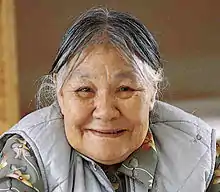  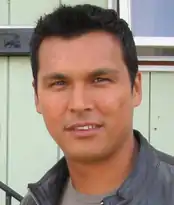 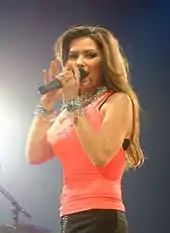 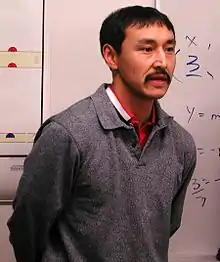  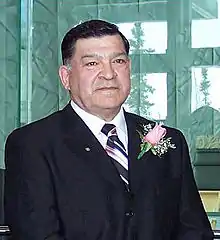  Over the course of centuries, many Indigenous Canadian personalities have played a critical role in shaping the history of Canada. From art and music, to law and government, to sports and war; Aboriginal customs and culture have had a strong influences on defining Canadian culture. |
- Na-Dene languages
- Nanfan Treaty
- Nahnebahwequa
- Nanook
- Nanook of the North
- National Aboriginal Day
- National Aboriginal Health Organization
- Native American cuisine
- Native American art
- Native Education Centre
- Native Friendship Centre
- Native Women's Association of Canada
- Nellie Cournoyea
- New World
- Nicola (chief)
- Nicola language
- Nicole Redhead
- Nine Years' War
- Nisga'a Final Agreement
- Nisga'a language
- North American fur trade
- Northwest Coast art
- Northwest Indian War
- Northern Regional Negotiations Table
- North West Company – North West fur Company (1779 to 1821)
- North-West Rebellion
- Norton tradition
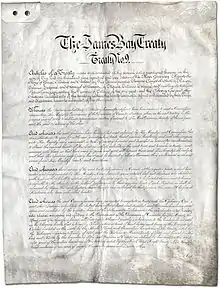 The Numbered Treaties are a series of eleven treaties signed between the aboriginal peoples in Canada and the reigning Monarch of Canada (Victoria, Edward VII or George V) from 1871 to 1921. Treaty 9 was an agreement established in July 1905, between King Edward VII and various First Nations in northern Ontario. |
- Treaty 1 – August 1871
- Treaty 2 – August 1871
- Treaty 3 – October 1873
- Treaty 4 – September 1874
- Treaty 5 – September 1875 (adhesions from 1908–1910)
- Treaty 6 – August–September 1876 (adhesions in February 1889)
- Treaty 7 – September 1877
- Treaty 8 – June 1899 (with further signings and adhesions until 1901)
- Treaty 9 – July 1905
- Treaty 10 – August 1906
- Treaty 11 – June 1921
O
P
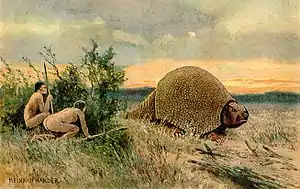 Paleo-Indians or Paleoamericans are believed the first peoples to enter and inhabit the Americas during the final glacial episodes of the late Pleistocene period. The few agreements achieved to date are their origin from Asia, with migration and widespread habitation of the Americas during the end of the Last glacial period, or more specifically what is known as the Late Glacial Maximum, around 16,000–13,000 years before present. |
- Paleo-Eskimo
- Paleo-Indians
- Payipwat (Piapot)
- Paulette Caveat
- Petun
- Penetanguishene Bay Purchase
- Pitikwahanapiwiyin (Poundmaker)
- Plano culture
- Plank house
- Plastic shaman
- Pittailiniit
- Plains Indians
- Point Peninsula Complex
- Police
- Population history of American indigenous peoples
- Potlatch
- Pontiac's Rebellion
- Pow-wow
- Powley ruling
- Pierre de Troyes, Chevalier de Troyes
- Pitikwahanapiwiyin
- Prince Albert Volunteers
- Pre-Columbian
- Public consultation
- Pwi-Di-Goo-Zing Ne-Yaa-Zhing Advisory Services
R
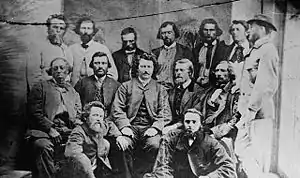 The Red River Rebellion or Red River Resistance are names given to the events surrounding the actions of the Provisional Government of Saskatchewan established by Métis leader Louis Riel in 1869 at the Red River Colony in what is now the Canadian province of Manitoba. |
- R. v. Badger
- R. v. Marshall; R. v. Bernard
- R. v. Marshall
- R. v. Drybones
- R. v. Gladstone
- R. v. Gonzales
- R. v. Guerin
- R. v. Sparrow
- R. v. Van der Peet
- Rancherie
- Re Eskimos
- Red Paint People
- Red River Rebellion
- Red River ox cart
- Royal Commission on Aboriginal Peoples
- Royal Proclamation of 1763
- Rupert's Land
S
- St. Catherines Milling v. The Queen
- St. Jude's Cathedral (Iqaluit)
- St. Lawrence Iroquoians
- Sacred bundle
- Salishan languages
- Saskatchewan Indian Institute of Technologies
- Saugeen Complex
- Saugeen Tract Agreement
- Section Thirty-five of the Constitution Act, 1982
- Section Twenty-five of the Canadian Charter of Rights and Freedoms
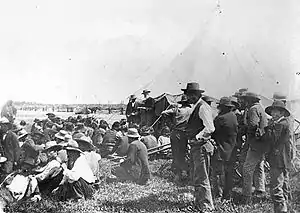 The status of the First Nations, aboriginal people of British Columbia, Canada, is a long-standing problem that has become a major issue in recent years. In 1763 the British Crown declared that only it could acquire land from First Nations through treaties. Historically only two treaties were signed with the First Nations of BC. The first of which was the Douglas Treaties of 1850–1854 with the second being Treaty 8, signed in 1899. |
- Secwepemc Cultural Education Society
- Secwepemc Museum and Heritage Park
- Settler Colonialism in Canada
- Seven Nations of Canada
- Shamanism among Eskimo peoples
- Shingwauk Kinoomaage Gamig
- Siqqitiq
- Sisiutl
- Sixty Years' War (1754–1814)
- A military struggle for control of the Great Lakes region in North America, encompassing several generations
- French and Indian War (1754–1763)
- Pontiac's Rebellion (1763–1765)
- Lord Dunmore's War (1774)
- Frontier warfare during the American Revolution (1775–1783)
- Northwest Indian War (1786–1794)
- War of 1812 (1812–1814)
- Skaay
- Sk'elep
- Skookum
- Squamish people
- Squamish culture
- Squamish history
- Squamish language
- Sled dog
- Spoken languages of Canada#Aboriginal languages
- Squaw
- St'at'imcets language
- Status of First Nations treaties in British Columbia
- Stereotypes of Native Americans
- Stó:lō
- Slahal
- Soulcatcher
- Spirit of Haida Gwaii
- Sun Dance
T
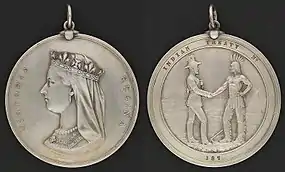 The relationship between The Canadian Crown and Aboriginal peoples of Canada stretches back to the first interactions between European colonialists and North American indigenous peoples. Over centuries of interaction, treaties were established concerning the monarch and aboriginal tribes. Canada's First Nations, Inuit and Métis peoples have come to generally view these agreements as being not between them and the ever-changing Cabinet, but instead with the continuous Crown of Canada, as embodied in the reigning sovereign. |
- The Canadian Crown and Aboriginal peoples (Main political article)
- Teiaiagon
- Terres en vues/Land InSights
- The Great Peacemaker
- Three Sisters (agriculture)
- Thunderbird Park (Victoria, British Columbia)
- Thule people
- Tlingit language
- Toggling harpoon
- Totem pole
- Travois
- Treaty of 1818
- Treaty of Fort Niagara
- Treaty of Hartford (1638)
- Tribal College Librarians Institute
- Tikigaq
- Treaty of Fort Niagara
- Tribal Council
- Tsimshian mythology
- Tunngavik Federation of Nunavut
- Two-Spirit
V
- Vancouver Aboriginal Child and Family Services Society
- Vancouver Métis Community Association
W
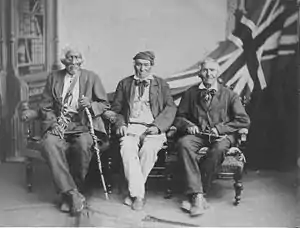 Sakawarton (John Smoke Johnson), John Tutela, and Young Warner, three Six Nations veterans of the War of 1812. The war was fought between the United States and the British Empire, particularly Great Britain and her North American colonies of Upper Canada (Ontario), Lower Canada (Quebec), New Brunswick, Newfoundland, Nova Scotia, Prince Edward Island, Cape Breton Island (at that time a separate colony from Nova Scotia), and Bermuda. |
- Waabnoong Bemjiwang Association of First Nations
- Wampum
- Wakashan languages
- Wawatay Native Communications Society
- War of 1812
- Chronology of the War of 1812
- War of 1812 Campaigns
- Niagara campaign
- Results of the War of 1812
- Tecumseh
- Tecumseh's War
X
Search
- Search all pages with prefix
- All pages beginning with "Aboriginal"
- All pages beginning with "First Nations"
- All pages beginning with "Inuit"
- All pages beginning with "Métis"
- Search all pages with title
- All pages with titles containing Aboriginal
- All pages with titles containing First Nations
- All pages with titles containing Inuit
- All pages with titles containing Métis
See also
- You can help by expanding short articles (stubs):
- Category:First Nations stubs
- Related:
- Index of Canada-related articles (Parent index of Canada)
- List of Canada-related topics by provinces and territories (Click-able maps)
External links
| Wikimedia Commons has media related to First Nations of Canada. |
| Wikimedia Commons has media related to Inuit. |
| Wikimedia Commons has media related to Metis. |
- Aboriginal Canada Portal
- Aboriginal Virtual Exhibits from Canadian Museums
- The Atlas of Canada—Explore Our Maps—History
- The Canadian Museum of Civilization-First Peoples Section
- CBC Digital Archives-The Battle for Aboriginal Treaty Rights
- Comprehensive and Specific Claims in Canada-Indian and Northern Affairs Canada
- Films about Aboriginal peoples at NFB.ca
- First Nations Studies Essays
- First Nations Seeker
- A History of Aboriginal Treaties and Relations in Canada
- Map of historical territory treaties with Aboriginal peoples in Canada
- Naming guidelines of Indian and Northern Affairs Canada, Government of Canada
- Report of the Royal Commission on Aboriginal Peoples
This article is issued from Wikipedia. The text is licensed under Creative Commons - Attribution - Sharealike. Additional terms may apply for the media files.